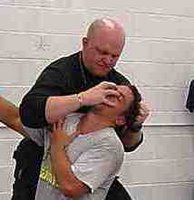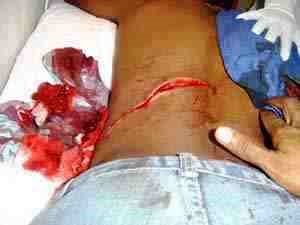 In the RealFighting.com article, "EDGED WEAPON TACTICS AND COUNTER TACTICS" by Darren Laur, he covers the dangers, misconceptions, and tactics to deal with these easily concealable stabbing and slashing weapons.
In the RealFighting.com article, "EDGED WEAPON TACTICS AND COUNTER TACTICS" by Darren Laur, he covers the dangers, misconceptions, and tactics to deal with these easily concealable stabbing and slashing weapons.Within its range, a Knife [as compared to firearms-NDT]:
- Never runs out of ammunition
- Never jams
- Never misfires
- Rarely misses its target
- Cuts bone, tendon, muscles, arteries, veins with one thrust
- Can bring about sudden shock, pain, and extended wound channels
- It has better stopping capabilities
- Is psychological defeating
- Has superior concealment capabilities
- It occupies a permanent wound channel until extracted, at whichtime, if the blade is withdrawn from a lung, consciousness is rapidly lost
If the attacker pulls a knife, consider him to be an expert
The best defense against an edged weapon is to not get into one in the first place. Watch for edged weapons, this means watching a person's hands. I have stated for years that the only assumption I make in a fight is that the person I am dealing with may have a concealed weapon that I don't see.
By being aware of the ways in which a person may deploy an edged weapon may give you the advantage to with the encounter. This means, get to know the technology available. Visit your local knife/ army surplus stores and see what is available.
Also look into how this technology is deployed:
- Listen for the unsnapping of a button on a knife case
- Listen for Velcro opening
- Listen for the click of a lock blade
- Movement behind the back
- Drawing motion of the arm/elbow
- The way in which a person may be packing a visible knife. A buck knife
case that is holstered with the snap opening down lets you know that this person had thought about using gravity to deploy the knife quickly.
Excellent article. I recommend you read it all, and integrate it into your training. Here is where a pure sport-training background will get you into trouble (as compared to a combatives/self-defense focus). Hock also has some excellent materials on this.


No comments:
Post a Comment